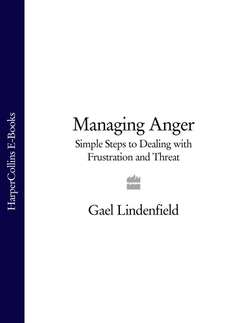Читать книгу Managing Anger: Simple Steps to Dealing with Frustration and Threat - Gael Lindenfield, Gael Lindenfield - Страница 19
RESPONSE 2 – VIA THE JUNGLE SPEEDWAY
ОглавлениеCathy once again is standing by her kitchen window, but today she is highly stressed. She is just about to drive off to a megaimportant emergency business meeting. She is late and has a headache. She has just had a row with her partner about having to work another evening this week. Now this parked car at the end of her drive is going to delay her even more. She thinks ‘How selfish and inconsiderate some people are. What right have they to block my private exit?! I’ll make sure they don’t do that again in a hurry!’
Cathy, on this occasion, is perceiving the threat as severe, so a variation on the above sequence takes place:
– A signal is sent directly to her amygdyla. (This also houses the ‘control centre’ for our fight/flight response. When a signal by-passes our thinking centre and travels down this fast track it is often referred to as an ‘Emotional Hijack’.)
– An impression of the trigger situation is scanned through a special emergency emotional ‘memory bank’. It is then rapidly matched with one of a limited number of neural blueprints for action. (These are sets of pre-coded instructions. Although it is not absolutely clear how these blueprints are formed, it is thought that both our genetic inheritance and our previous experience of highly charged emotional experiences play important roles.)
– Cathy’s brain immediately sets in motion biochemical changes designed to put her nervous system instantly into a state of high arousal and produce an emotional state of rage. (In effect, her body and mind is being prepared for a physical ‘fight’, even though in modern society this might be quite an inappropriate and dangerous way to respond to the threat.)
– Cathy feels furious.
– Her face goes white, her heart beats faster and her muscles contract. She is propelled into instant action.
– She ‘charges’ out of the door to deal with the offending car and its driver. With the sound of the banging door ringing in her ears, she doesn’t, of course, hear her partner calling to tell her that it’s the doctor! Neither, in her ‘blinding’ rage, does she see the doctor-on-call sticker on the windscreen before she scratches it with her own car keys!
The moral of these two stories is not just ‘Don’t park anywhere near Cathy’s house’! It is, of course: ‘Never let your anger go joyriding down the Jungle Speedway!’
– respiration deepens
– the heart beats more rapidly
– blood pressure rises
– the pupils dilate
– the sympathetic nervous system diverts blood from the skin, liver, stomach and intestines to the heart, central nervous system and muscles
– the digestive processes are suspended
– glucose is freed from the reserves in our liver
– Cortisol production is increased in order to depress the immune system
– the spleen contracts and discharges its content of concentrated corpuscles
– men have an increased supply of the male hormone testosterone.
We become aware of:
– feelings of warmth (even when it is quite cold)
– a feeling of energy (in spite of any tiredness)
– our heart palpitating
– taking deeper breaths than usual
– not feeling hungry
– clearer and more focused vision
– more acute hearing
– a desire to yell out
– an urge to move our limbs quickly and forcefully.
What other people may notice:
– we are panting
– our pulse is racing (if they are brave enough to try and feel it!)
– our eyes are more widely open than usual and our pupils are dilated
– our facial colour deepens, but then may turn pale
– we are more sensitive to sound
– we have more physical strength than usual
– our voice is louder
– our speech is quicker
– our movements are quicker
– our muscles are tense (fists clenched, face contorted and shoulders arched).
